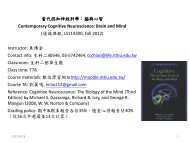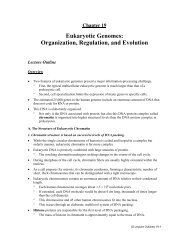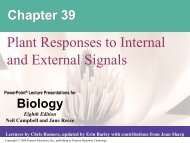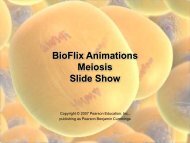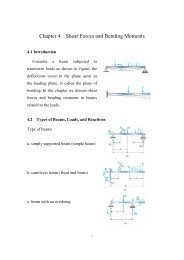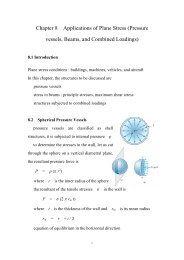CHAPTER 17 FROM GENE TO PROTEIN
CHAPTER 17 FROM GENE TO PROTEIN
CHAPTER 17 FROM GENE TO PROTEIN
- No tags were found...
You also want an ePaper? Increase the reach of your titles
YUMPU automatically turns print PDFs into web optimized ePapers that Google loves.
• The genetic code is nearly universal, shared by organisms from the simplest bacteria to themost complex plants and animals.• In laboratory experiments, genes can be transcribed and translated after they are transplantedfrom one species to another.° This has permitted bacteria to be programmed to synthesize certain human proteins afterinsertion of the appropriate human genes.• Such applications are exciting developments in biotechnology.• Exceptions to the universality of the genetic code exist in certain unicellular eukaryotes andin the organelle genes of some species.° Some prokaryotes can translate stop codons into one of two amino acids not found inmost organisms.• The evolutionary significance of the near universality of the genetic code is clear.° A language shared by all living things arose very early in the history of life—earlyenough to be present in the common ancestors of all modern organisms.• A shared genetic vocabulary is a reminder of the kinship that bonds all life on Earth.B. The Synthesis and Processing of RNA1. Transcription is the DNA-directed synthesis of RNA: a closer look.• Messenger RNA, the carrier of information from DNA to the cell’s protein-synthesizingmachinery, is transcribed from the template strand of a gene.• RNA polymerase separates the DNA strands at the appropriate point and bonds the RNAnucleotides as they base-pair along the DNA template.° Like DNA polymerases, RNA polymerases can only assemble a polynucleotide in its 5’ 3’ direction.° Unlike DNA polymerases, RNA polymerases are able to start a chain from scratch; theydon’t need a primer.• Specific sequences of nucleotides along the DNA mark where gene transcription begins andends.° RNA polymerase attaches and initiates transcription at the promoter.° In prokaryotes, the sequence that signals the end of transcription is called the terminator.• Molecular biologists refer to the direction of transcription as “downstream” and the otherdirection as “upstream.”• The stretch of DNA that is transcribed into an RNA molecule is called a transcription unit.• Bacteria have a single type of RNA polymerase that synthesizes all RNA molecules.• In contrast, eukaryotes have three RNA polymerases (I, II, and III) in their nuclei.° RNA polymerase II is used for mRNA synthesis.• Transcription can be separated into three stages: initiation, elongation, and termination of theRNA chain.• The presence of a promoter sequence determines which strand of the DNA helix is thetemplate.° Within the promoter is the starting point for the transcription of a gene.IG Lecture Outlines <strong>17</strong>-5




